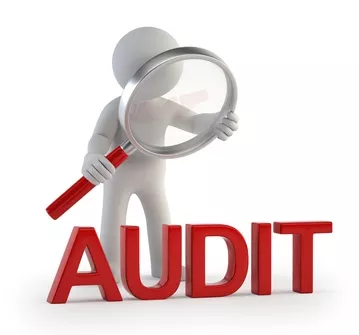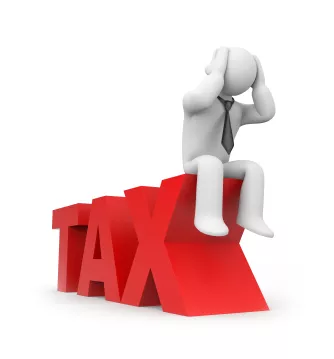- Essential Bookkeeping Habits For Audit Ready Books in Canada
- GST HST In Canada
- How To Cancel Your GST HST Account
Cancel Your GST HST Account: The Financial Impact
By L.Kenway BComm CPB Retired
Edited September 7, 2024 | Revised March 29, 2024 | Updated March 7, 2024 | Originally Published on Bookkeeping-Essentials.com in September 2012
WHAT'S IN THIS ARTICLE
Overview | Financial Impact | Steps to Close | Closing Process | Neutral Tax | Reasons to Deregister | More Info | Chair Yoga
NEXT IN SERIES >> Basics of PST in B.C.
What is the financial impact of closing your Goods and Services Tax / Harmonized Sales Tax (GST HST) account? Do you have to pay back any Input Tax Credits (ITCs)?
 What are the financial implications when you cancel your GST HST account?
What are the financial implications when you cancel your GST HST account?Overview
In the past, to cancel your GST HST account, you had to fill out CRA's form RC145 Request to Close Business Number (BN) Accounts. The form was mailed or faxed to your tax services office. This option is still available.
Nowadays, you also have the option to use My Business Account services (or your bookkeeper can use Represent a Client services). Once you are signed in, get yourself in the GST/HST section. You should see "Close GST/HST account" as one of the CRA services offered on My Business Account.
Before you cancel, make yourself aware of the financial impact from closing your GST HST account.
Chair Yoga Stretches
Small Daily Habit Can Move Mountains
Sitting for extended periods of time is often coined as the new smoking due to its harmful effects on health. Prolonged sedentary behaviour can lead to chronic diseases such as diabetes, obesity, cardiovascular diseases, and even depression or anxiety. Just like passive smoking, such a sedentary lifestyle could be harmful, even to those who engage in regular physical activity.
To reduce these negative impacts, taking frequent stretch breaks is key. It's recommended to stand up, stretch, or walk around every 30 to 60 minutes. This not only aids in promoting good blood flow, digestion, and focus, but also helps in reducing the risk of developing musculoskeletal problems like back, neck, and shoulder pain. I find it's easy to accomplish if you don't keep things in reaching distance, forcing you to get up to use the printer or scanner for example.

If you are desk bound, incorporating Chair Yoga poses into your stretch breaks can be beneficial. Three effective poses for desk-workers include:
- "Wrist and Finger Exercises " which reduces the likelihood of wrist tendinitis;
- "Chair Pigeon Pose" that helps with tight hips caused by sitting; and
- "Seated Twist Pose" to relieve back and neck pain. Seated twisted pose is one of my favourites.
These poses take only a few minutes, only require your desk chair to perform, and can easily fit into your office routine, making your desk work healthier and more comfortable.
References: Yale Medicine Why is Sitting so Bad for Us?; Yoga Beyond the Studio Office Yoga: 8 Yoga Poses You Can Do At Work; Yoga Journal 5 Ways to Practice Pigeon Pose
The Financial Impact of Cancelling Your GST HST Account
There are a few things you need to be aware of before you cancel your GST/HST account as there will be a financial impact.
- When you are a small supplier, you must have your GST/HST account open for at least twelve months before you can close/cancel (deregister) your registration. Your revenues must fall below the $30,000 annual threshold to register. There are some exceptions for taxi drivers, ride-sharing drivers, and non-resident performers. They do not have the option to deregister once they have registered.
- Any capital property the business owns becomes a deemed disposition under change of use rules. Deemed disposition means CRA considers you to have disposed of all property right before you cancel your GST HST account. Deemed dispositions can result in a capital gain or a capital loss.
It also means you must self assess and pay GST HST when you cancel your GST HST account because you have changed the primary use from commercial to non-commercial. Remember, GST HST is a neutral tax to businesses but not consumers.
Example
For example, let's say you have a lawn mowing business and bought a lawn mower that cost $1,100.
The GST paid at time of purchase was $55. The $55 input tax credit was claimed on your GST HST return. Now the mower is a year old with a fair market value (FMV) estimated at $880.
You will have to pay GST HST using CRA's formula upon de-registering of ($55 ITC - $0 rebate) x ($880 FMV / $1,100 OC [original cost]) = $44 ITC to be repaid. This number gets reported on line 105 of your final GST HST return. - When you cancel your registration, any non-capital property held in supply such as inventory is deemed to be sold/disposed of at FMV. You will be responsible for collecting GST/HST on these items as well as reporting and remitting it to CRA on your last return.
- If you have any prepaid arrangements, you must adjust your final return for any input tax credits provided after you close your account.
Navigating GST HST Account Cancellation with CRA
When managing a business, circumstances may call for you to cancel your GST HST account with the Canada Revenue Agency (CRA). Whether you're selling your business, halting operations, or simply no longer fulfilling the requirements to charge GST HST, below are the key steps you need to follow:
1. Ensure Everything is Up-to-Date: Before initiating your GST HST account cancellation, ensure all your tax returns have been filed and all dues are cleared. This includes all other taxes linked to your business as well. The easiest way to find this information is in the online My Business Account portal. It lets you know of any outstanding returns or taxes owing.
2. Contact CRA: Reach out to the Canada Revenue Agency either through your 'My Business Account' on the CRA website (or their business enquiries line at 1-800-959-5525).
3. Submit a Request: After logging into your business account on the CRA website, navigate to 'Manage account' and select 'Close account'. Here you will submit a request to close your GST HST account.
4. Provide Required Information: You will need to provide important details related to your business - the reason for account closure, the effective closure date, and details of the last return you plan to submit. The last return will include self-assessing any GST owing on the sale or disposition of your businesses capital and non-capital property.
5. File Final Return: Once your cancellation request is accepted, you will have to file a final GST HST return that considers your business activity until the day of closure.
6. Await Confirmation: After the submission of the final return, CRA will cancel your GST HST account and send you an official notice of account closure.
AFTER YOU'VE CANCELLED
Remember, when you cease charging GST HST, you must inform your clients promptly, and you are no longer authorized to issue tax invoices for GST/HST.
By following these steps and keeping a clear line of communication with CRA, you will ensure a smooth and compliant transition when canceling your GST/HST account.
Online Process To Cancel Your GST HST Account
In step 4 mentioned above, you have to state the reason you are closing your account. On their webpage "Open or manage an account - Close", it lists some scenarios:
- You are closing your business
- You are selling your business
- You are a sole proprietor that is a small supplier
- You are no longer making taxable supplies
- You are filing for bankruptcy
- You are in receivership
- You are merging with another business
- The sole proprietor has passed away
- A member of a partnership has retired or passed away
It puzzles me as to why anyone would want to their GST/HST account if they are still in business. GST/HST is a neutral tax to business because suppliers can claim an input tax credit to offset it against GST HST charged on sales. It is an effective way to reduce your total taxes paid.
The small supplier threshold to register for GST HST is income over $30,000 annually. Many small businesses operate at a loss the first few years, so being able to claim your input tax credits helps a small business reduce taxes and manage your cash flow.
THE QUICK METHOD - ANOTHER ALTERNATIVE
If you are staying in business and are mainly a service business or have very few input tax credits, consider electing to switch to the Quick Method where you will likely make a small profit from filing your GST HST return. With this method, you still collect GST HST but you only remit a prescribed percentage of the tax collected to CRA. There is a reduction in paperwork because you are no longer tracking your GST HST expenses, just your sales.
Why GST HST is a neutral tax to business
GST HST is defined in law at Part IX of the Excise Tax Act (ETA). It is considered a neutral tax for businesses in Canada because there is generally not a cost to them. They collect it from customers and pass it on to the government.
When businesses make purchases for their operations, they pay GST HST, but they can claim it back as Input Tax Credits (ITCs) when they file their taxes, effectively offsetting the GST HST they’ve collected.
Therefore, the business is simply collecting the tax on behalf of the government and the impact to the business's bottom line is neutral. This kind of taxation is also referred to as an indirect tax.
I talk more about why GST HST was introduced in Canada as well as how it is different from PST (Provincial Sales Tax) in the GST HST Guide if you are interested.
Are there any reasons why a small business would want to Deregister for GST HST?
Even though I would never make that choice, there are reasons why a small business might want to deregister or not want to voluntarily register for GST HST for that matter.
- If a business has revenues under the small supplier limit ($30,000), it’s not required to collect GST HST.
- Voluntarily registering means that the business owner has to collect and remit this tax to the government and comply with associated administrative work, like filing tax returns. This might be burdensome for a very small business, especially if they deal with mostly end consumers (who cannot claim ITCs) because it effectively increases the price of goods or services while reducing the business's expenses.
- Not having to include the tax in their prices could give small businesses a competitive advantage over larger businesses in the same niche that have to charge it.
Where To Go For More Information
You can find out more information on how to close your GST/HST account on the CRA website*.
- On CRA's homepage, type "closing accounts" in the search bar.
- Click on "Closing CRA program accounts".
- Click on "Open or manage an account - Close".
- Read through the instructions on how to proceed.
AUDIT READY
Make sure you pay attention to the section at the bottom on the page titled "After you close your GST/HST account". All or part of your ITCs previously claimed on capital property have to be repaid. You also have to deal with the GST/HST from the deemed sale of your non-capital property.
*I like to give my readers the CRA path so they can learn how to find information on the website ... and because every time the site gets reorganized, I have trouble ... sometimes ... finding my reference source again.








